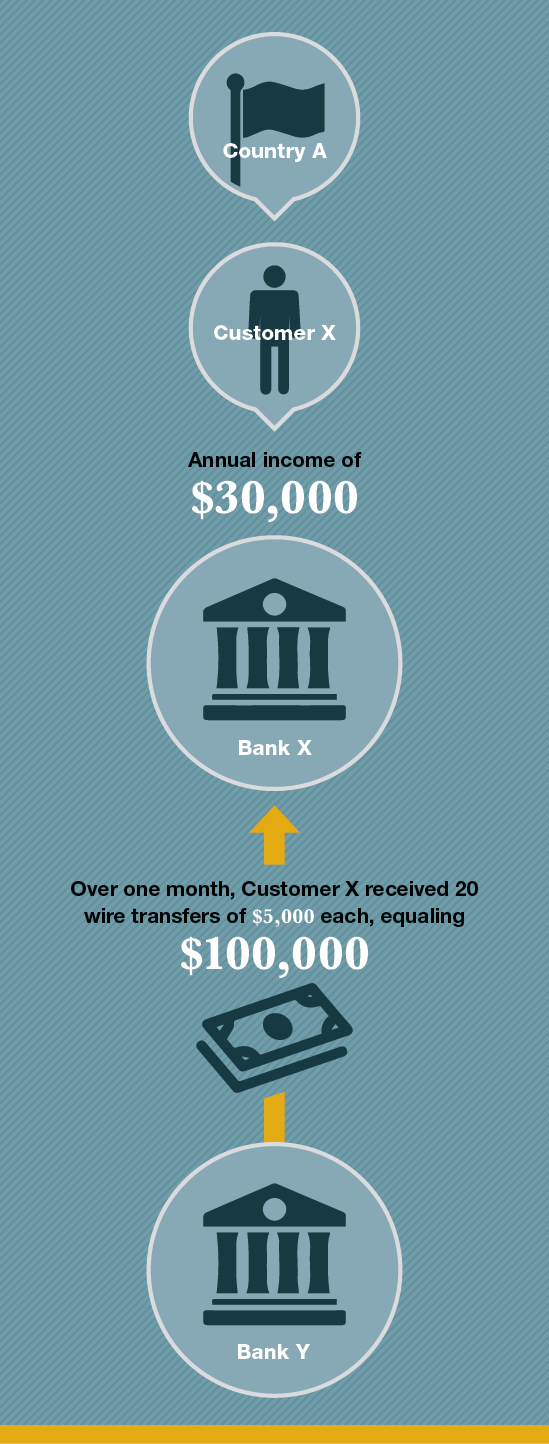An informal group of financial sleuths is critical to fighting transnational crime
By Joseph Wheatley, trial attorney, Organized Crime and Gang Section, U.S. Department of Justice
Transnational crime, including terrorist financing, money laundering and other offenses, tends to exploit the financial system, operate covertly, move quickly and show little regard for national borders. These and other factors often make transnational crime difficult to investigate and prove in court. To overcome these hurdles, countries need, among other things, swift access to financial information, robust capabilities to analyze that financial information, and the means to disseminate such financial information and analysis quickly to investigators and prosecutors within a country and across countries.
Financial intelligence units (FIUs), established by more than 150 countries around the world, help fill that need in the investigation and prosecution of transnational crime. These government agencies, among their various roles, support law enforcement authorities by receiving, analyzing and disseminating financial intelligence so that it may be used quickly and effectively in investigations and prosecutions. Further, FIUs assist their foreign counterparts through the Egmont Group, an informal network of FIUs.
What is an FIU?
Broadly speaking, an FIU is a government agency that receives, analyzes and disseminates financial intelligence. The Financial Action Task Force, an intergovernmental policymaking body responsible for establishing policies to combat money laundering and terrorist financing, released international standards in 2012 that said an FIU is a “national centre for the receipt and analysis of: (a) suspicious transaction reports; and (b) other information relevant to money laundering, associated predicate offences and terrorist financing, and for the dissemination of the results of that analysis. The FIU should be able to obtain additional information from reporting entities, and should have access on a timely basis to the financial, administrative and law enforcement information that it requires to undertake its functions properly.”
FIUs receive, analyze and disseminate the kinds of financial intelligence described below. FIUs follow four organizational models: judicial, law enforcement, administrative and a hybrid that combines aspects of the three other models.

The Egmont Group
Founded in 1995 at the Egmont Arenberg Palace in Brussels, Belgium, the Egmont Group (www.egmontgroup.org) is an informal network of FIUs drawn from more than 150 member states. The group serves as a forum and platform for FIUs to cooperate on a variety of issues. Just as an FIU may assist law enforcement authorities in its own country, FIUs working with other FIUs through the Egmont Group may assist law enforcement authorities in other countries that are investigating terrorist financing, money laundering and other offenses.
The Egmont Group provides support to FIUs in a number of ways, including formalizing and expanding the exchange of financial intelligence, training and expertise, and secure communication facilities between FIUs. The group is open to applications from FIUs interested in joining.
Financial intelligence
There is no single definition for the financial intelligence that FIUs receive, analyze and disseminate. However, financial intelligence tends to encompass the following two categories of records that are generated by reporting entities, namely financial institutions, including banks, money transmitters and casinos:
Declarations/disclosures that are based on a threshold reporting level. This includes cash transaction reports, also known as currency transaction reports, and wire transfer reports. Such declarations/disclosures must be filed by reporting entities for each transaction that crosses a specified threshold or appears to be structured to avoid the threshold reporting requirement. For instance, in the United States, financial institutions are required to file a currency transaction report for transactions above $10,000, or for those that appear to be structured to avoid the reporting requirement, such as when a person deposits $9,999 on multiple occasions.
Suspicious transaction reports, also known as suspicious activity reports. Suspicious reports are treated as confidential and may not be disclosed outside of FIU and law enforcement authorities. Unlike the declarations/disclosures described above, suspicious transaction reports are not based on a threshold reporting level. Regardless of the size of the transaction, reporting entities are obliged to file suspicious transaction reports when they observe financial behavior that may reflect criminal activity. For instance, transactions that are outside a bank customer’s normal pattern or serve no obvious economic or business purpose may reflect money laundering and cause the bank to file a suspicious transaction report.
Three important tools
The financial intelligence described above is analyzed and disseminated by FIUs, which train reporting entities and can help with investigations and prosecutions of transnational crime in three important ways: investigate leads, freeze or suspend transactions, and provide evidence in legal proceedings.
In the first instance, financial intelligence can help identify leads such as names, dates, locations and account numbers. For instance, consider this hypothetical scenario: In Country A, Customer X has a consumer bank account at Bank X. When Customer X applied to open the account in early 2018, he provided information about himself, including his annual income of $30,000. He has had the bank account for two months. Over one month, Customer X received 20 wire transfers of $5,000 each. The wire transfers came from a single U.S. bank account at Bank Y. That totals $100,000 in one month, from one originating account.
This behavior may strike the bank as suspicious because the total of the wire transfers far exceeded Customer X’s reported income, each transfer was beneath the $10,000 reporting threshold, and Customer X has had the account for only two months but has already received $100,000 in wire transfers.
Such irregular behavior may cause Bank X to file a suspicious transaction report about Customer X. Although the suspicious transaction report would remain confidential, as required, the report may be used as an investigative lead to obtain potentially admissible evidence, including the underlying records that caused the bank to file the suspicious transaction report. For instance, investigators could interview Customer X, obtain the records for Customer X’s account and the records for the account where the wire transfers originated at Bank Y, and interview the account holder of that originating account.
Such evidence, discovered using a suspicious transaction report as an investigative lead, could later be used with other evidence to prove criminal offenses, including money laundering and fraud. For instance, records from the originating and destination bank accounts may show that Customer X controlled both and could help prove that he artificially inflated business expenses by sending money to himself and structured the transactions to avoid the $10,000 reporting requirement. Again, while the suspicious transaction report itself remains confidential, it may steer investigators and prosecutors toward helpful evidence that may be used in legal proceedings, including the records that triggered the suspicious transaction report.

In an example cited by the Egmont Group in 2014, the Serbian FIU found tax evasion by Serbian residents who used wire transfers through multiple countries to distance themselves from the original source of the funds. The Serbian FIU uncovered this tax evasion by reviewing suspicious transaction reports submitted by a Serbian bank and by working with other Egmont Group FIUs, including those in Malta, the Philippines and the U.S., to trace the suspicious transactions across those countries. The Serbian FIU then reported this information to a law enforcement authority, the Serbian Tax Administration, which concluded that the Serbian residents committed tax evasion; the residents had to pay $344,000 in restitution.
In another example cited by the Egmont Group in 2014, the U.S. FIU assisted federal agencies, including Homeland Security and the U.S. Army’s Criminal Investigation Command (CID), with the investigation of Efraim Diveroli and others for fraud against the U.S. government involving the sale of prohibited military munitions. The assistance provided by the U.S. FIU to the CID and other investigative agencies included the sharing of suspicious transaction reports, research and analysis. It helped bring the investigation to a successful conclusion and prevented the sale of prohibited ammunition and a loss of tax dollars. In 2011, Diveroli was sentenced to four years in prison; his co-defendants were also convicted.

In an example cited by the Egmont Group in its 2015-2016 annual report, the Israeli FIU uncovered a sophisticated money-laundering operation that used false documents, diamond imports/exports and wire transfers to launder hundreds of millions of dollars. The Israeli FIU discovered the fraud by observing a surge in suspicious transaction reports from the financial industry between 2007 and 2009, and by working with other Egmont Group FIUs, including those in Belgium, Hong Kong, Thailand, the United Kingdom and the U.S., to help identify companies, accounts and transactions involved in the money laundering. This financial intelligence aided an investigation by Israeli law enforcement authorities, including the prosecutors and the police, which charged 15 entities in 10 indictments.
The second important way in which financial intelligence can be helpful involves the freezing or suspending of financial transactions. In 2009, the Egmont Group found that 54 percent of FIUs have the authority to take that action. By freezing or suspending transactions, countries may prevent suspected wrongdoers from hiding or disposing of their assets before formal charges are filed. Likewise, these powers may be used to implement international sanctions.
Using financial intelligence as evidence in a legal proceeding is a third way it can be helpful. As described above, one type of financial intelligence, suspicious transaction reports, are confidential and may not be disclosed publicly. However, when permitted, a second type of financial intelligence, declarations/disclosures that are based on a threshold reporting level, may be used as evidence in legal proceedings. For instance, in a 2006 press release, the U.S. FIU reported that currency transaction reports, which are based on threshold reporting requirements, were used in the prosecution and conviction of a drug-trafficking organization, which used casinos to launder drug proceeds.
Conclusion
FIUs, the Egmont Group, and financial intelligence play an important role in the investigation and prosecution of transnational crime. By analyzing and disseminating financial intelligence, namely suspicious transaction reports and declarations/disclosures based on threshold reporting requirements, FIUs may assist investigations and prosecutions, including the three ways discussed in this article: investigative leads, freezing or suspending transactions, and providing potentially admissible evidence in legal proceedings. This assistance may occur within a given country or between FIUs through the Egmont Group. Only through cooperation within and among countries can law enforcement agencies address the pressing problem of transnational crime.



Comments are closed.